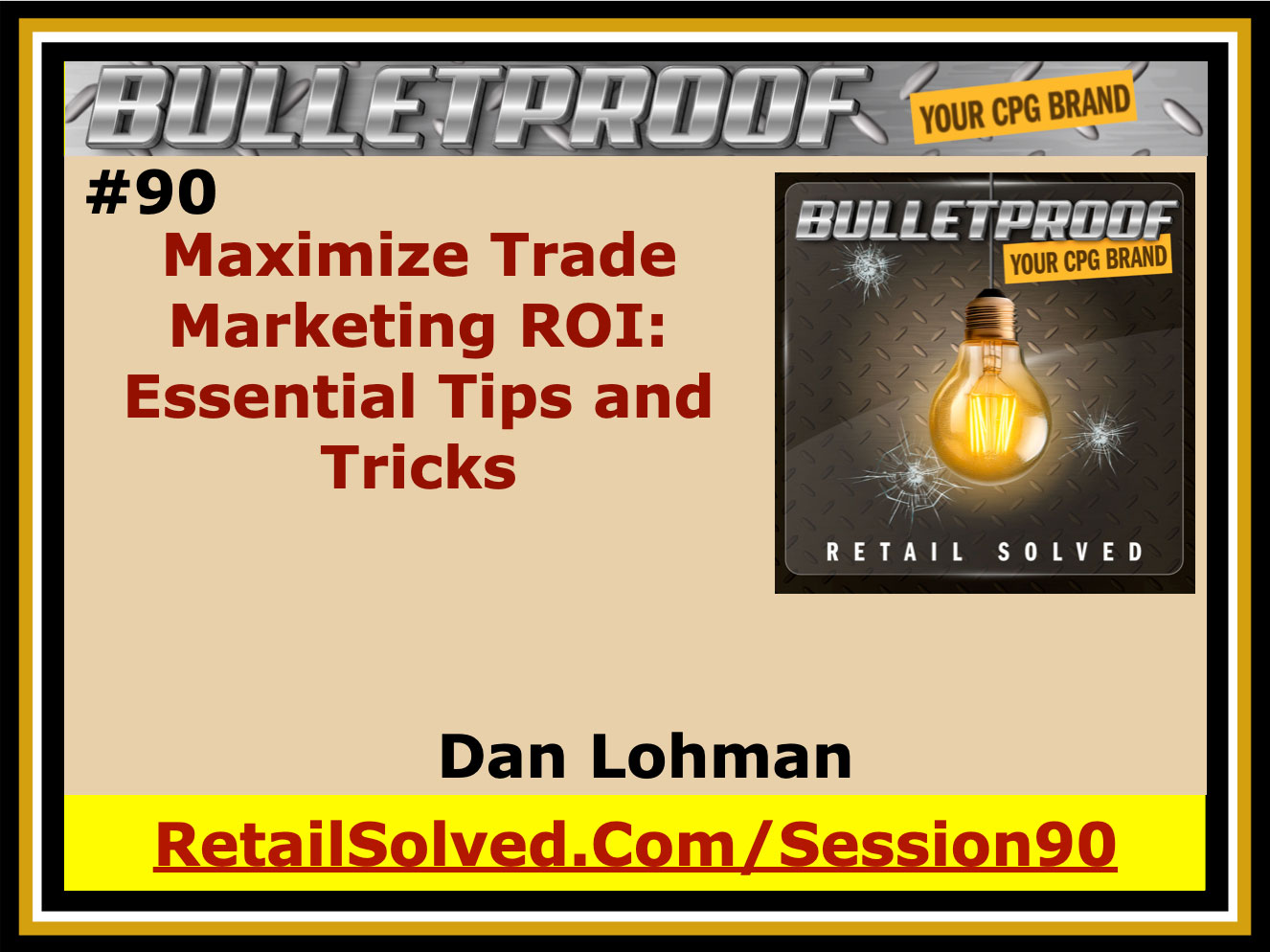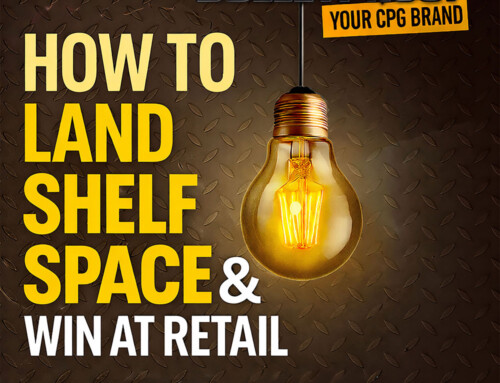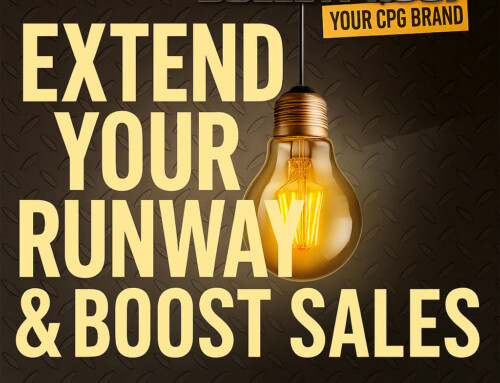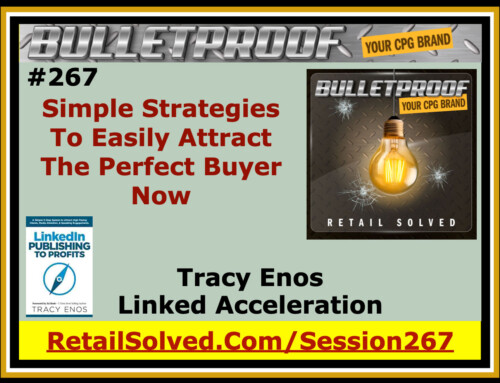Elevate your brand by maximizing trade marketing ROI. Learn effective tactics for getting products into shoppers' hands. Trade marketing, includes everything to get products into shoppers’ hands. It is crucial for brand success. Measuring its effectiveness is challenging. While promotions increase sales, many are ineffective, diluting brand contribution and failing to attract new customers.
Trade marketing encompasses everything required to get your products into shoppers hands. Maximizing trade effectiveness combined with digital strategies is the best way to get your products onto more retailers shelves and into the hands of more shoppers.
Listen where you get your podcast
Important: Brand Secrets and Strategies has been rebranded to Retail Solved. Please swap all BrandSecretsandStrategies.com URL’s with RetailSolved.com. This is now the Bulletproof Your Brand podcast. Thank you for listening! BRAND SECRETS AND STRATEGIES PODCAST #90 Hello and thank you for joining us today. This is the Brand Secrets and Strategies Podcast #90 Welcome to the Brand Secrets and Strategies podcast where the focus is on empowering brands and raising the bar. I’m your host Dan Lohman. This weekly show is dedicated to getting your brand on the shelf and keeping it there. Get ready to learn actionable insights and strategic solutions to grow your brand and save you valuable time and money. LETS ROLL UP OUR SLEEVES AND GET STARTED! Before we begin I want to remind you that the show is about you and it's for you. The goal here is the help you get your product onto more retailers shelves and into the hands of more shoppers. If you liked this podcast share with a friend, subscribe, and leave a review. Trade marketing encompasses everything required to get your products into shoppers hands. This includes slotting, menu fees, temporary price reductions, displays, and much much more. Maximizing trade effectiveness combined with digital strategies is the best way to get your products onto more retailers shelves and into the hands of more shoppers. Let's face it, retail is expensive - especially in traditional brick-and-mortar retailers. It seems as though from the brand perspective that everyone has their hand out. Brands find themselves feeling as though they are an ATM machine. Sadly, the perception is that a brands checkbook is the most important tool in their toolbox when working with retailers and distributors. The current strategy is to continually raise money to support or fund every promotion regardless how effective it is. For most brands, this is simply not sustainable. Trade marketing is typically the single largest line item on a company’s income sheet, but how do you know if your trade marketing is effective? This is something that most brands struggle with. This is an area that I’ve had great success in including developing several advanced tools to analyze promotional effectiveness including one that measures the contribution from a promotion at the brand level for a specific retailer or promotion. Measuring promotional effectiveness can be extremely challenging, even more so in natural. This is due to the lack of quality resources needed to effectively measure a promotions effectiveness. For example, not every retailer or distributor shares their sales data. To measure the effectiveness of your promotion you need to know exactly how much product gets delivered to the store and how much product gets scanned through their registers during the promotion. Another challenge is that promotions don't align with the data reporting periods - syndicated data providers typically end there reporting weeks over the weekend while promotions typically begin and end during the middle of the week. There are many other challenges to measuring the effectiveness of a promotion that I'll cover more in-depth in future courses and podcast. I've seen estimates that as much as 70 to 90% of all trades spending is wasted or ineffective. That sounds like a pretty bold claim, let me explain. The primary purpose of every promotion should be to introduce your product to new customers - PERIOD. The reality is that your promotional dollars do little to increase new customer trials. Don't get me wrong, the sales increase or lift that you get from a promotion is key to driving sales at retail but ineffective promotions actually take dollars out of the category and dilute your brands contribution. Ineffective promotions include out-of-stocks, poor product merchandising, the wrong promoted price point, poor coordination between the retailer and the brand, competitive promotions that overshadow your promotions, effective messaging or advertising, etc. Several years ago I did a project for a natural retailer to help them understand the importance of their sales data. I found an example where a legacy natural brand set up a promotion for the retailer that included a great price point. By all accounts the promotion should've been a huge success for the brand and the retailer. The problem was that the brand was not in distribution at each of the retailer stores. To further complicate things, merchandising of the brand was inconsistent from one store to another. The stores that had the product in distribution quickly ran out of stock because the brand and the retailer had not anticipated the increased inventory needed to support the promotion. During the promotion angry customers were demanding the product across every store including those with no distribution. To complicate things, the retailer begged their distributor for more product. This caused the distributor to be out-of-stock which in turn caused other retailers to be out of stock. This is an example of a complete failure on the part of the brand, the retailer, and the distributor to maximize every selling opportunity. Sadly, the brand took the brunt of the complaints across every retailer in the market. Perception matters! This is why it's imperative to maximize each and every selling opportunity - the focus of this podcast, my courses, and all of my content. Your brand's contribution is perhaps the most effective metric that every brand should pay attention to. While most brands focus on their products ranking in the category along with their sales increase, few brands take into consideration what's really driving sales. It's possible to dramatically increase your brands sales velocity through deep and frequent promotions that dilute your brands contribution to the category and the retailer. This can artificially enhance a brands ranking in the category on paper while making the brand susceptible to competitive threats. I want to back up and talk about a couple key concepts. First is the difference between sales and base sales. Your sales are simply the sum total of all your sales. Base sales however are your sales in the absence of a promotion. This is a key metric that most brands overlook. Brands should focus on their base sales trends. This helps you assess the health of your brand. The other key concept is contribution. Your contribution is the profitable dollars that your brand delivers to the category. Contribution is measured by your sales where you have distribution. The measure you should use to calculate contribution is your dollars per point of distribution or $SPP. I recently launched a mini course called How To Assess The Health Of Your Brand where I dig deep into this important topic. You can access this valuable resource by going to the courses tab on my website brandsecretsandstrategies.com. I mentioned that most promotions are ineffective and fail to encourage new shopper trials – the primary goal of every promotion. While rewarding loyal shoppers to make repeat purchases can prove beneficial, new shopper engagement is the key to growing brand sales longterm. More importantly, effective promotions help retailers compete more effectively by driving shopper traffic into their stores and away from their competition. This is the greatest bargaining chip any brand can offer a retailer. Digital strategies level the playing field for small brands and provide a substantial competitive advantage. Savvy brands leverage their ability to drive retailer sales when they negotiate with retailers for premium shelf space, incremental merchandising opportunities, preferential promotions, etc. Shopper buying habits have changed. We live in a digitally connected world - shoppers expect transparency and authenticity. Shoppers today research brands online while standing in front of the product. They look to see how the product is used, what their peers think of it, if the product fits their nutritional needs, how transparent the ingredients are, new recipes, and so on. Leverage your digital strategy to enhance and amplify promotions that are retailer specific. Today shoppers look beyond the four corners of a package. Because of this important dynamic, brands need to re-think about the way they promote their products and who they promote their products to. Here are several strategies to maximize your trade marketing ROI Online retail. Brands today should have both a traditional retail strategy and an online retail strategy. Developing a strong online presence is a great way to help brands introduce and sell their products to new customers beyond the confines of a traditional retailers four walls. This is a great way to gain runway by more effectively using your trade spending to drive sales with less overhead. Digital strategies. Social media is the great equalizer between large and small brands. Social media allows a brand to communicate with a much larger audience more effectively for dramatically less than using traditional media. Larger brands tend to talk at us while smaller brands tend to have a more intimate relationship with their customers. It's imperative that brands “own” their customers by developing a strong and robust community around them. Having the ability to communicate directly with your customers can help you turn them into loyal evangelists for your products. This is also great way to reward them for their loyal support. One strategy is to provide them with exclusive incentives and opportunities. For example new product introductions could be shared with you're loyal community before appearing on traditional retailer shelves. You could also offer incentives like by ten and get one free or free shipping if they purchase a case of your products. Leverage your online presence with traditional retailers. This is perhaps the most underutilized brand sales story strategies. Every retailer wants two know that if they put your product on their shelves it will increase their category sales. Being able to show your sales growth online illustrates your brands ability to connect with customers. This translates to your ability to also drive sales in traditional retail as well. Leveraging your online presence to drive sales in traditional retailers. For example, promoting on Amazon in a specific ZIP Code that aligns with a Whole Foods store. There is a direct correlation between online and traditional brick and mortar retailers. When you consider that Amazon is perhaps the largest brand search engine, this provides an excellent opportunity for brands to showcase detailed information about their products. Creativity. Most promotions lack creativity. Brands tend to repeat prior promotions or mimic competitor promotions. Companies that have creative strategies typically have greater success growing sustained sales. Effective promotions encourage incremental and impulse purchases. Co-promoting within the brand and with complimentary items when possible usually results in greater sales lifts and the ability to split the promotional fees across other products. Even better, digital strategies allow brands to drive consumer engagement. Promotions that align with the retailers digital strategy help exponentially drive awareness and traffic to both the retailer and the brand. The ultimate goal is to increase consumer purchases after the promotion ends. Digital strategies can also be very effective in measuring shopper engagement using some the strategies previously mentioned. Purpose. Every promotion should have a well-defined and understood purpose that aligns with your customers. Design promotions around opportunities to build your brand such as important causes like Earth Day, back-to-school, etc). Consistent brand messaging. Most promotions fail to connect with your core shoppers. Build a strategy around your consumer’s specific needs and wants. Communicate a consistent message across all marketing vehicles by integrating sales strategies through different mediums including and especially with social media. Plan ahead. Be prepared to support the promotion by having additional product on hand. Use category management principles to accurately predict consumer takeaway and to identify the ultimate promotion price point. Out-of-stocks are a huge problem for some brands. Never miss a sale due to poor planning on your part. Also, a few cents off in either direction can dramatically affect consumer sales/take away. Strong brand building strategy - scorecarding. Promotions that don’t grow category and brand sales are a huge waste of resources and money. Set specific goals and objectives for each promotion, then evaluate promotions afterward to highlight successes and/or missed opportunities. Account for all costs including deductions, digital strategies, retailer fees, scan down rate, bill back, missed sales due to out-of-stocks, off-invoice rebates, menu fees, fixed costs, forward buys and miscellaneous costs when evaluating promotion effectiveness. Include retail, distributor, broker, and supplier execution in your evaluation. Promotion schedule. Some companies have very predictable promotion schedules that train customers to purchase their brand only when they are on sale. While it’s nice to reward consumers for being loyal, the goal of all promotions is to encourage shoppers to be loyal and to invite new customers to try your products. A more effective way to reward existing shoppers is with digital strategies that provide exclusive incentives and coupons. Learn your competitors’ strategies and the effectiveness of their promotions. Build your strategy around your competitors promotional efforts to maximize every opportunity to invite their shoppers to try your brand. Efficient trade fund management. This can be one of the most difficult areas to effectively manage due to the complexity of differing retailer programs and systems. Identify and adopt systems that allow you to effectively manage trade spending, cash flow across simultaneous promotions at multiple retailers, promotion reconciliation, deductions, and promotion analysis and inventory movement throughout the supply chain. Integrate your system with your retailer and market data to maximize your results. This will be covered more in-depth in future podcasts and courses. Pay on scan. Promotions can be set up a lot of different ways. The most effective way to manage promotions and improve your ROI is to pay for what shoppers purchase. The way this works is to set up promotions that reimburse retailers for items scanned through their registers. This is far better than paying a lump sum and taking a chance that the retailer may not help you drive sales at every location. Paying for a promotion that doesn't include some form of accountability on the retailers part is a huge waste of money. Personalization. Personalization is your key to success. This recommendation can do more to set you apart from your competition, help you drive profitable sustainable sales, and help you gain the incremental distribution necessary to cement your success. Your customers want to feel valued and important. They want to be appreciated and they want products that fits their individual specific needs. Having a personal intimate relationship with your customers gives you distinct competitive advantage. Think about it, we buy products that are friends endorse and celebrate. Being able to develop this kind of relationship with your customers is easy if you build a supportive community around them. For example, new moms, allergy sufferers, people who are gluten intolerant, extreme athlete, vegans, etc. Trade marketing is one of the most important and most overlooked strategies for most brand. While it can be extremely confusing and challenging to manage deductions, promotional fees, etc. It can also be the single most important growth engine for your brand. Leveraging the strategies above can add rocket fuel to your growth - empowering brands raising the bar. I appreciate you for listening. Thank you for your support. Today's free downloadable guide is: 8 Strategies To Maximize Trade Marketing ROI. You can get it on this shows webpage or in the show notes. You can download this week show notes at brandsecretsandstrategies.com/session90. I look forward to seeing you in the next episode. This episode's FREE downloadable guide Most promotional spending is ineffective and wasted. Effective promotions expand runway, grow sustainable sales & maximize your promotional ROI. CLICK HERE TO DOWNLOAD YOUR FREE STRATEGIC GUIDE: 8 Strategies To Maximize Trade Marketing ROI Thanks again for joining us today. Make sure to stop over at brandsecretsandstrategies.com for the show notes along with more great brand building articles and resources. Check out my free course Turnkey Sales Story Strategies, your roadmap to success. You can find that on my website or at TurnkeySalesStoryStrategies.com/growsales. Please subscribe to the podcast, leave a review, and recommend it to your friends and colleagues. Sign up today on my website so you don’t miss out on actionable insights and strategic solutions to grow your brand and save you valuable time and money. I appreciate all the positive feedback. Keep your suggestions coming. Until next time, this is Dan Lohman with Brand Secrets and Strategies where the focus is on empowering brands and raising the bar.
Enter your name and email address below and I'll send you periodic brand building advice, tips and strategies.
Sign up to receive email updates
FREE Trade Promotion ROI Calculator:
Click Here To Maximize Sales And Profits
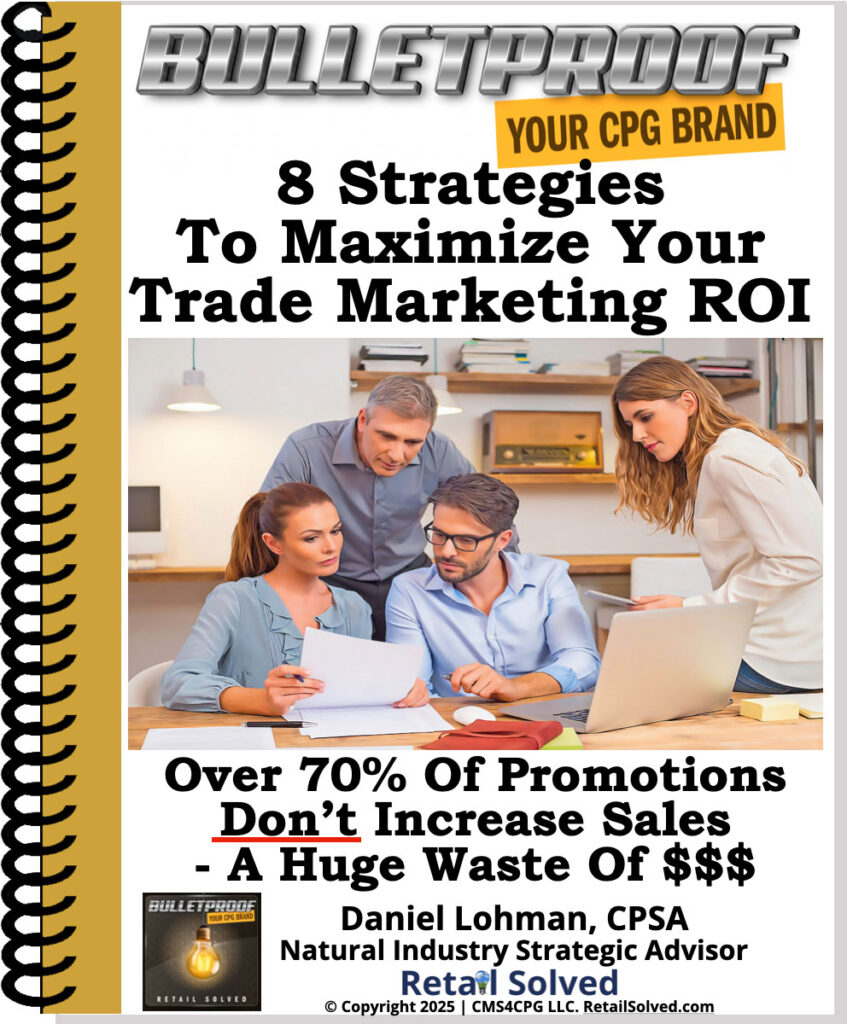
Want 8 Proven Strategies To Maximize Trade Marketing ROI?
Tired of wasting money? Most promotional spending is ineffective and wasted. Effective promotions expand your runway, make your brand more attractive to investors, grow sustainable sales & maximize your promotional ROI. Trade marketing typically represents about 25% of your gross sales and yet 70% of it is often wasted or ineffective. Learn simple strategies to fix this and put more cash in your pocket to grow and scale your brand.
Image is the property of CMS4CPG LLC, distribution or reproduction is expressively prohibited.
